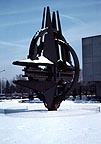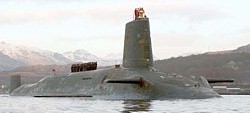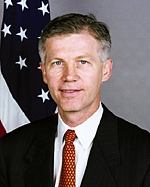 |
|
NATO nuclear thinking seems frozen in time. |
US Nukes Needed
in Europe Because of Invisible Enemy and Russia, NATO Says
Nuclear Brief October 6, 2005
U.S. nuclear weapons need to continue to be deployed in
Europe as defense against unknown future enemies and because of Russia's
non-strategic nuclear weapons.
This justification was provided by
Ed Kronenburg,
director of the NATO General Secretary's Private Office, in response to
a joint letter signed by Ian Davis (British American Security
Information Council), Daryl Kimball (Arms Control Association), John
Sloboda (Oxford
Research Group), and myself. On June 6, 2005, we asked NATO General
Secretary Jaap de Hoop Scheffer begin the process of removing all
non-strategic nuclear weapons from Europe. Specifically, we asked that
NATO:
- facilitate a dialogue among NATO member states on
the process by which such weapons may be permanently withdrawn to
the United States.
- make a withdrawal process verifiable and
transparent by confirming the location and number of non-strategic
nuclear weapons in NATO member states.
Withdrawing the weapons would be in tune with U.N.
General Assembly resolution 59-75 from October 2004, which called for
further reductions in non-strategic nuclear weapons. This resolution was
supported by all NATO member states except the United States.
|
No Policy
Change |
 |
|
NATO DPO Ed Kronenburg uses old and unknown
adversaries to rule out any changes in NATO's nuclear policy. |
The Answer Is No!
Unfortunately, but not entirely surprisingly,
Ed Kronenburg rejected any reduction in NATO's nuclear posture due to "a wide range of future challenges, which cannot be predicted with
certainty." Moreover, he said, while NATO reduced its non-strategic
nuclear weapons in Europe in the early 1990s, "there is no evidence of
equivalent reductions in the Russian non-strategic nuclear weapons
stockpile."
In rejecting changes to NATO nuclear posture in
Europe, Kronenburg called NATO strategic and non-strategic nuclear
weapons "an indivisible whole." Specifically, he claimed that:
- While overall developments in the evolving
strategic environment have been generally positive, uncertainties
and risks remain which could develop into acute crisis and present
new security challenges. In this context, Allies believe that the
Alliance's long-term security continues to require an appropriate
mix of conventional and nuclear forces for the foreseeable future to
sustain deterrence.
- NATO nuclear policy must serve a long-term
perspective in order to preserve peace and security against a wide
range of future challenges, which cannot be predicted with
certainty.
- The Alliance's strategic and sub-strategic forces
provide an indivisible whole, with the latter providing an enduring
political and military link between the European and North American
members of the Alliance, while permitting collective sharing of
nuclear risks and responsibilities -- thereby demonstrating the
common commitment of all Allies to deterrence and collective
defense.
- Allies see nuclear reductions as a continuing
step-by-step process which must be achieved in a prudent, gradual
manner. While NATO has significantly reduced its stockpile of
sub-strategic weapons in Europe, there is no evidence of equivalent
reductions in the Russian non-strategic nuclear weapons stockpile.
- Under the auspices of the NATO-Russia Council,
NATO continues to work with Russia to progress the development of
nuclear confidence and security building measures (CSBMs) with
the ultimate aim of improving security in the Euro-Atlantic area. As
these develop, the Alliance hopes that Russia will feel able to
respond positively to its commitments under the Presidential
Initiatives of 1991 and 1992.
 |
|
Ever since HMS Victorious sailed on its first
patrol in December 1995, British strategic submarines have also
had a "sub-strategic" mission, presumably against some of the
same targets covered by U.S. non-strategic bombs deployed in
Europe. |
All of these justifications are well known and have
been used frequently by NATO since the end of the Cold War. Indeed, some
date as far back as to the height of the Cold War itself. None of them,
however, are very good anymore. They
show an alliance that is surprisingly
stuck in the past and hasn't thought very carefully about the future.
- First, although "uncertainties and risks"
certainly exist (as they always have and always will), forward
deployed U.S. nuclear non-strategic bombs in Europe provide no unique deterrence
effect that cannot be achieved with other long-range nuclear weapons
deployed in the United States. Moreover, since December 1995,
British ballistic missile submarines on patrol have performed a
"sub-strategic" mission (in addition to their strategic mission) in
support of NATO, presumably covering the same potential targets that
the U.S. non-strategic nuclear bombs in Europe would be used
against.
- Second, "future challenges, which cannot be
predicted with certainty" cannot and should not serve as the basis
for nuclear planning. Nuclear planning must be directed against
known and tangible adversaries, not phantoms. Planning against
threats that "cannot be predicted with certainty" result in
inadequately tested policies, poorly
planned missions, and maintenance of forces that could otherwise be
retired or transferred to real-world non-nuclear missions.
- Third, while it is true that strategic and
non-strategic forces provide "an indivisible whole," this is because
all the nuclear weapon states in NATO since 1991 have sought to
erase a distinction between strategic and non-strategic nuclear
weapons. Today, all nuclear weapons are "strategic"
due to their unique ramifications. And if strategic and
non-strategic nuclear weapons truly provide an "indivisible whole,"
as Kronenburg argues, then the non-strategic weapons are no longer
needed in Europe because strategic weapons can just as well fulfill
the same mission.
- Fourth, U.S. non-strategic nuclear weapons in
Europe do not provide an "enduring" political and military link
between the European and North American members of the Alliance.
Rather, they appear to represent a temporary delay in the drawdown
of the Cold War in Europe. The aura of
the weapons is fading rapidly, with several allies having curtailed
or ended their nuclear strike role altogether (nuclear weapons were even
removed from Greece in 2001), and others such as Germany and Belgium
likely to follow in the future. Moreover, one of the two North
American member states -- Canada -- gave up its nuclear strike
role in 1984, does not want nuclear weapons on its territory, and has
advocated changing NATO nuclear policy. To base NATO's long-term cross-Atlantic link on
the fading status of U.S. non-strategic nuclear weapons
in Europe is a serious miscalculation. Rather, NATO
would be better off basing its hopes and aspirations for an enduring cross-Atlantic link on
the real-world non-nuclear missions that are important to the alliance.
- Fifth, "permitting collective sharing of nuclear
risks and responsibilities" seems to be the wrong emphasis for an
organization whose member states are trying to make
non-proliferation of nuclear weapons the core pillar of
post-Cold War security. How credible is that message, for example,
when Germany sends its diplomats to Iran to persuade Teheran not to
pursue nuclear weapons capability, while German fighter bombers back
at Büchel Air Base and Nörvenich Air Base are equipped -- and German
fighter pilots practice -- to deliver U.S. nuclear bombs in times of
war? Nonproliferation will fail without universal standards, and
nuclear sharing in NATO undercut those standards.
- Sixth, that the deployment of U.S. nuclear
weapons in Europe somehow demonstrates "the common commitment of all
Allies to deterrence and collective defense" glosses over the
reality that most of NATO's member states do not have nuclear
weapons on their territory, don't what any, and have no aircraft
serving a NATO nuclear strike role. On the
contrary, the trend in NATO is that non-nuclear member states -- and
especially the new member states -- do not want nuclear weapons on
their territories. There may be a common commitment within the
alliance to deterrence
and collective defense in general, but not necessarily to U.S.
nuclear weapons in Europe.
The Russian Factor
Kronenburg's final justification, the number of Russia's
non-strategic nuclear weapons, is not new either but is presented in a new way.
While military planners have raised the issue numerous times during the
1990s, U.S. Assistant Secretary of State Stephen Rademaker accused the
Russians during a visit to Moscow in October 2004 for not having met
fully a pledge from 1991 to reduce their tactical nuclear weapons. Back
then, Russia pledged:
- All nuclear artillery ammunition and nuclear
warheads for tactical missiles will be destroyed;
- Nuclear warheads of anti-aircraft missiles
will be removed from the army and stored in central bases. Part
of them will be destroyed. All nuclear mines will be destroyed;
- All tactical nuclear weapons will be removed
from surface ships and multipurpose submarines. These weapons,
as well as weapons from ground-based naval aviation, will be
placed in central storage areas. Part of them will be destroyed.
 |
|
U.S. Assistant Secretary of State, Stephen G. Rademaker,
says Russia has not met its 1991 pledge to cut non-strategic
nuclear weapons |
The occasion
for raising the issue in 2004 appears to have be the U.S. completion in 2003 of its
own nuclear weapons dismantlements in accordance with former President George Bush's
Presidential Nuclear Initiatives from 1991 and 1992.
Following Rademaker's remarks, the Russian Foreign Ministry
quickly fired back saying that it had
announced in May 2004 that, "more than 50% of the total nuclear
ammunition for sea-based tactical missiles and naval aviation,
antiaircraft missiles and nuclear aviation bombs has been liquidated."
Moreover, the ministry said, "the reduction of tactical nuclear weapons
is continuing."
During the Non-Proliferation Review Conference in
2000, Russian Foreign Minister Igor Ivanov stated that Russia was about
to complete implementation of the Presidential Nuclear Initiatives. Two
years later, in April 2002, the work was still not done, as the Russian
government said that it
had "practically implemented all the declared initiatives to reduce
[non-strategic nuclear weapons] with the exception of elimination of
nuclear weapons of the Army." They would be eliminated by 2004,
depending on funding, the ministry promised. In April 2004, Russia
repeated this assessment, but the 2004 deadline was missing.
The U.S. has not specified which portion of the
Russian Presidential Nuclear Initiatives that has not been fully met,
but the Russian statement in April 2002 suggests that it may concern Army
weapons. If so, it means that Kronenburg is using Russian ground-launched
army weapons as an excuse for not changing NATO's deployment of
air-delivered bombs.
Kronenburg's letter even goes a step further, saying
that "While NATO has significantly reduced its stockpile of
sub-strategic weapons in Europe, there is no evidence of equivalent
reductions in the Russian non-strategic nuclear weapons stockpile."
Yet Russia's Presidential Nuclear Initiative did not pledge "equivalent"
reductions, but elimination of nuclear artillery, tactical missiles, and
mines. Other weapons, including anti-aircraft missiles and naval
weapons, would be reduced.
Conclusion and Recommendations
Neither Russia nor the United States has permitted verification of
their reductions under the Presidential Nuclear Initiatives. During most of the 1990s
it was possible to verify the number of U.S. warheads dismantled at the
Pantex Plant, but in 1999 the Department of Energy decided to classify
dismantlement numbers. Neither country provide information about the
status of their non-strategic nuclear forces.
When Rademaker expressed the U.S. concern about
Russia's implementation of the 1991 Presidential Nuclear Initiative, he
also claimed that it was Russia's non-strategic nuclear weapons -- not
NATO's -- that concerned people in Europe:
"I can assure you that when European audiences
talk about the problem of
tactical nuclear weapons in Europe, their concern is directed toward
the
Russian tactical nuclear weapons and what countries they might be
targeted on rather than the relatively small number of tactical
nuclear
weapons that remain in the NATO arsenal."
While this may have been the mood during the Cold War,
it no longer seems to be the case. It is not a Russian attack people
fear as much as poor security at the nuclear weapons storage sites which
may one day result in loss of control of a nuclear weapon. Contrary to
Rademaker's assertion, this concern does not make people favor NATO's
deployment. In Germany, for example, more than two-thirds of the
population (across the political spectrum) favor a removal of U.S.
nuclear weapons despite the Russian situation. People seem to be
concerned about both Russian and NATO nuclear weapons.
Clearly, both the United States and Russia need to
move beyond Cold War bickering and provide verifiable access to the
status of their non-strategic nuclear weapons stockpiles. And NATO needs
to update its analysis of the pros and cons of deploying U.S. nuclear
weapons in Europe.
» See also:
U.S. Nuclear Weapons In Europe.
|

